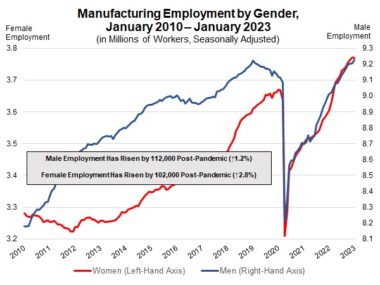More Women Join the Manufacturing Workforce

Fresh off International Women’s Day, which was March 8, there’s some encouraging news on the labor front: more women are coming back to the workforce, both in manufacturing and throughout the economy.
In manufacturing: Female employment in the industry reached its height this year, with a total of 3.77 million workers, according to NAM calculations based on BLS numbers.
NAM calculations based on BLS numbers.
- Women now account for 29% of the manufacturing workforce.
- A year ago this week, the Manufacturing Institute, the NAM’s 501(c)3 workforce development and education partner, launched its 35×30 campaign, an initiative that aims to boost women’s share of the manufacturing workforce to 35% by 2030.
The overall economy: “Women have gained more jobs than men for four straight months, including in January’s hiring surge, pushing them to hold more than 49.8% of all nonfarm jobs,” according to The Wall Street Journal (subscription).
- “Female workers last edged higher than men on U.S. payrolls in late 2019, before the pandemic sent nearly 12 million women out of jobs, compared with 10 million men.”
Why it’s happening: The child-care disruptions and health concerns that made many women leave the workforce during the pandemic are diminishing, while employers offer historically high pay and increasing numbers of remote positions.
Why it’s important: More women in the workforce could help ease both worker shortages and inflation.
- With January unemployment reaching a 53-year low, “[a] greater supply of labor could work to counter rising wages and align with the Federal Reserve’s goal of cooling inflation,” according to the Journal.
- More job seekers could also help U.S. manufacturers, whose job openings edged up to 803,0000 in January.
The last word: “In just a year, the 35×30 campaign has made great strides in increasing the number of women in manufacturing—and the latest data show as much,” said MI President Carolyn Lee. “We’re close to our goal. Together, we can get the rest of the way there and make it to 35% by 2030.”
